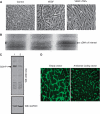A truncated form of CD9-partner 1 (CD9P-1), GS-168AT2, potently inhibits in vivo tumour-induced angiogenesis and tumour growth
- PMID: 21863033
- PMCID: PMC3185932
- DOI: 10.1038/bjc.2011.303
A truncated form of CD9-partner 1 (CD9P-1), GS-168AT2, potently inhibits in vivo tumour-induced angiogenesis and tumour growth
Abstract
Background: Tetraspanins are transmembrane proteins known to contribute to angiogenesis. CD9 partner-1 (CD9P-1/EWI-F), a glycosylated type 1 transmembrane immunoglobulin, is a member of the tetraspanin web, but its role in angiogenesis remains to be elucidated.
Methods: We measured the expression of CD9P-1 under angiogenic and angiostatic conditions, and the influence of its knockdown onto capillary structures formation by human endothelial cells (hECs). A truncated form of CDP-1, GS-168AT2, was produced and challenged vs hEC proliferation, migration and capillaries' formation. Its association with CD9P-1, CD9, CD81 and CD151 and the expressions of these later at hEC surface were analysed. Finally, its effects onto in vivo tumour-induced angiogenesis and tumour growth were investigated.
Results: Vascular endothelial growth factor (VEGF)-induced capillary tube-like formation was inhibited by tumour necrosis factor α and was associated with a rise in CD9P-1 mRNA expression (P<0.05); accordingly, knockdown of CD9P-1 inhibited VEGF-dependent in vitro angiogenesis. GS-168AT2 dose-dependently inhibited in vitro angiogenesis, hEC migration and proliferation (P<0.05). Co-precipitation experiments suggest that GS-168AT2 corresponds to the sequence by which CD9P-1 physiologically associates with CD81. GS-168AT2 induced the depletion of CD151, CD9 and CD9P-1 from hEC surface, correlating with GS-168AT2 degradation. Finally, in vivo injections of GS-168AT2 inhibited tumour-associated angiogenesis by 53.4±9.5% (P=0.03), and reduced tumour growth of Calu 6 tumour xenografts by 73.9±16.4% (P=0.007) without bodyweight loss.
Conclusion: The truncated form of CD9P-1, GS-168AT2, potently inhibits angiogenesis and cell migration by at least the downregulation of CD151 and CD9, which provides the first evidences for the central role of CD9P-1 in tumour-associated angiogenesis and tumour growth.
Figures







Similar articles
-
CD9P-1 expression correlates with the metastatic status of lung cancer, and a truncated form of CD9P-1, GS-168AT2, inhibits in vivo tumour growth.Br J Cancer. 2011 Feb 1;104(3):496-504. doi: 10.1038/sj.bjc.6606033. Epub 2011 Jan 4. Br J Cancer. 2011. PMID: 21206492 Free PMC article.
-
The Ig domain protein CD9P-1 down-regulates CD81 ability to support Plasmodium yoelii infection.J Biol Chem. 2009 Nov 13;284(46):31572-8. doi: 10.1074/jbc.M109.057927. Epub 2009 Sep 17. J Biol Chem. 2009. PMID: 19762465 Free PMC article.
-
The tetraspanins CD9 and CD81 regulate CD9P1-induced effects on cell migration.PLoS One. 2010 Jun 21;5(6):e11219. doi: 10.1371/journal.pone.0011219. PLoS One. 2010. PMID: 20574531 Free PMC article.
-
[Tetraspanins: a new target for antiangiogenic therapy?].Ann Pharm Fr. 2015 Mar;73(2):100-7. doi: 10.1016/j.pharma.2014.07.002. Epub 2014 Sep 4. Ann Pharm Fr. 2015. PMID: 25745942 Review. French.
-
LYP, a bestatin dimethylaminoethyl ester, inhibited cancer angiogenesis both in vitro and in vivo.Microvasc Res. 2011 Sep;82(2):122-30. doi: 10.1016/j.mvr.2011.05.008. Epub 2011 Jun 12. Microvasc Res. 2011. PMID: 21664364 Review.
Cited by
-
Site-specific functionality and tryptophan mimicry of lipidation in tetraspanin CD9.FEBS J. 2020 Dec;287(24):5323-5344. doi: 10.1111/febs.15295. Epub 2020 Apr 7. FEBS J. 2020. PMID: 32181977 Free PMC article.
-
Prostaglandin F2 receptor negative regulator as a potential target for chimeric antigen receptor-T cell therapy for glioblastoma.Cancer Immunol Immunother. 2025 Mar 6;74(4):136. doi: 10.1007/s00262-025-03979-4. Cancer Immunol Immunother. 2025. PMID: 40047938 Free PMC article.
-
Tspan8 and Tspan8/CD151 knockout mice unravel the contribution of tumor and host exosomes to tumor progression.J Exp Clin Cancer Res. 2018 Dec 12;37(1):312. doi: 10.1186/s13046-018-0961-6. J Exp Clin Cancer Res. 2018. Retraction in: J Exp Clin Cancer Res. 2025 Jan 16;44(1):16. doi: 10.1186/s13046-025-03284-z. PMID: 30541597 Free PMC article. Retracted.
-
Tetraspanins in cell migration.Cell Adh Migr. 2015;9(5):406-15. doi: 10.1080/19336918.2015.1005465. Epub 2015 Jun 19. Cell Adh Migr. 2015. PMID: 26091149 Free PMC article. Review.
-
EWI2 and its relatives in Tetraspanin-enriched membrane domains regulate malignancy.Oncogene. 2023 Mar;42(12):861-868. doi: 10.1038/s41388-023-02623-8. Epub 2023 Feb 14. Oncogene. 2023. PMID: 36788350 Free PMC article. Review.
References
-
- Al-Mahmood S (2000) Gene signal international SA, method for identifying novel genes involved in the regulation of angiogenesis, study of said genes and use thereof for therapeutic purposes, US patent no. 6716585
-
- Al-Mahmood S, Colin S, Farhat N, Thorin E, Steverlynck C, Chemtob S (2009) Potent in vivo anti-angiogenic effects of GS-101, an antisense oligonucleotide preventing the expression of Insulin Receptor Substrate-1. J Pharmacol Exper Thera 329: 496–504 - PubMed
-
- Al-Mahmood S, Colin S, Schneider C (2005) Gene signal international SA, genes involved in regulating angiogenesis, pharmaceutical preparations containing same and applications thereof, EP patent no. 1566387
-
- André M, Chambrion C, Charrin S, Soave S, Chaker J, Boucheix C, Rubinstein E, Le Naour F (2009) In situ chemical cross-linking on living cells reveals CD9P-1 cis-oligomer at cell surface. J Proteomics 73: 93–102 - PubMed
-
- Balsari A, Tortoreto M, Besusso D, Petrangolini G, Sfondrini L, Maggi R, Ménard S, Pratesi G (2004) Combination of a CpG oligodeoxynucleotide and a topoisomerase I inhibitor in the therapy of human tumour xenografts. Eur J Cancer 40: 1275–1281 - PubMed
Publication types
MeSH terms
Substances
LinkOut - more resources
Full Text Sources
Other Literature Sources
Medical

